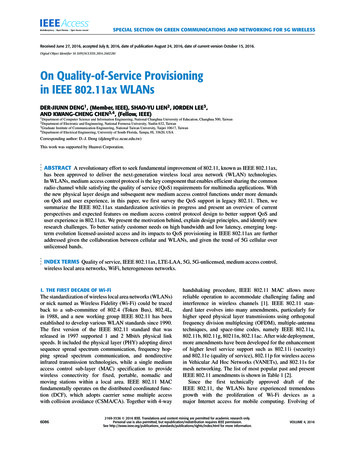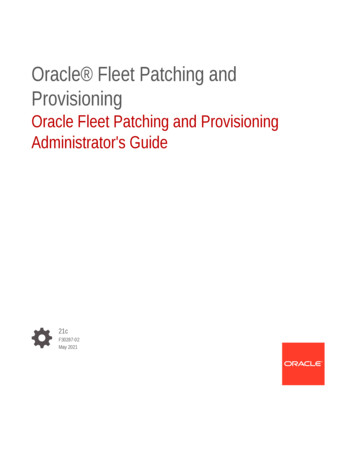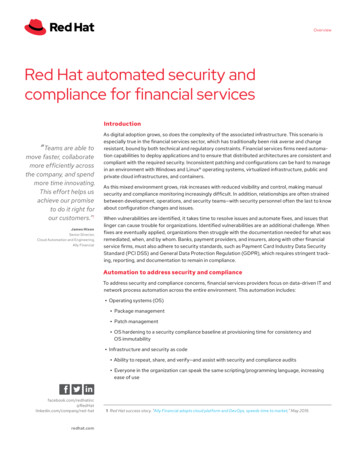
Transcription
SPECIAL SECTION ON GREEN COMMUNICATIONS AND NETWORKING FOR 5G WIRELESSReceived June 27, 2016, accepted July 8, 2016, date of publication August 24, 2016, date of current version October 15, 2016.Digital Object Identifier 10.1109/ACCESS.2016.2602281On Quality-of-Service Provisioningin IEEE 802.11ax WLANsDER-JIUNN DENG1 , (Member, IEEE), SHAO-YU LIEN2 , JORDEN LEE3 ,AND KWANG-CHENG CHEN3,4 , (Fellow, IEEE)1 Departmentof Computer Science and Information Engineering, National Changhua University of Education, Changhua 500, Taiwanof Electronic and Engineering, National Formosa University, Yunlin 632, TaiwanInstitute of Communication Engineering, National Taiwan University, Taipei 10617, Taiwan4 Department of Electrical Engineering, University of South Florida, Tampa, FL 33620, USA2 Department3 GraduateCorresponding author: D.-J. Deng (djdeng@cc.ncue.edu.tw)This work was supported by Huawei Corporation.ABSTRACT A revolutionary effort to seek fundamental improvement of 802.11, known as IEEE 802.11ax,has been approved to deliver the next-generation wireless local area network (WLAN) technologies.In WLANs, medium access control protocol is the key component that enables efficient sharing the commonradio channel while satisfying the quality of service (QoS) requirements for multimedia applications. Withthe new physical layer design and subsequent new medium access control functions under more demandson QoS and user experience, in this paper, we first survey the QoS support in legacy 802.11. Then, wesummarize the IEEE 802.11ax standardization activities in progress and present an overview of currentperspectives and expected features on medium access control protocol design to better support QoS anduser experience in 802.11ax. We present the motivation behind, explain design principles, and identify newresearch challenges. To better satisfy customer needs on high bandwidth and low latency, emerging longterm evolution licensed-assisted access and its impacts to QoS provisioning in IEEE 802.11ax are furtheraddressed given the collaboration between cellular and WLANs, and given the trend of 5G cellular overunlicensed bands.INDEX TERMS Quality of service, IEEE 802.11ax, LTE-LAA, 5G, 5G-unlicensed, medium access control,wireless local area networks, WiFi, heterogeneous networks.I. THE FIRST DECADE OF Wi-FiThe standardization of wireless local area networks (WLANs)or nick named as Wireless Fidelity (Wi-Fi) could be tracedback to a sub-committee of 802.4 (Token Bus), 802.4L,in 1988, and a new working group IEEE 802.11 has beenestablished to develop various WLAN standards since 1990.The first version of the IEEE 802.11 standard that wasreleased in 1997 supported 1 and 2 Mbit/s physical linkspeeds. It included the physical layer (PHY) adopting directsequence spread spectrum communication, frequency hopping spread spectrum communication, and nondirectiveinfrared transmission technologies, while a single mediumaccess control sub-layer (MAC) specification to providewireless connectivity for fixed, portable, nomadic andmoving stations within a local area. IEEE 802.11 MACfundamentally operates on the distributed coordinated function (DCF), which adopts caerrier sense multiple accesswith collision avoidance (CSMA/CA). Together with 4-way6086handshaking procedure, IEEE 802.11 MAC allows morereliable operation to accommodate challenging fading andinterference in wireless channels [1]. IEEE 802.11 standard later evolves into many amendments, particularly forhigher speed physical layer transmissions using orthogonalfrequency division multiplexing (OFDM), multiple-antennatechniques, and space-time codes, namely IEEE 802.11a,802.11b, 802.11g, 80211n, 802.11ac. After wide deployment,more amendments have been developed for the enhancementof higher level service support such as 802.11i (security)and 802.11e (quality of service), 802.11p for wireless accessin Vehicular Ad Hoc Networks (VANETs), and 802.11s formesh networking. The list of most popular past and presentIEEE 802.11 amendments is shown in Table 1 [2].Since the first technically approved draft of theIEEE 802.11, the WLANs have experienced tremendousgrowth with the proliferation of Wi-Fi devices as amajor Internet access for mobile computing. Evolving of2169-3536 2016 IEEE. Translations and content mining are permitted for academic research only.Personal use is also permitted, but republication/redistribution requires IEEE permission.See http://www.ieee.org/publications standards/publications/rights/index.html for more information.VOLUME 4, 2016
D.-J. Deng et al.: On QoS Provisioning in IEEE 802.11ax WLANsTABLE 1. Early approved IEEE 802.11 amendments.WLAN technologies have focused on multiple aspects interms of data rate, security, efficiency, etc. IEEE 802.11Working Group (WG) recently celebrated its 25th anniversaryduring July 2015 at a plenary session in Waikoloa, Hawaii.From the first quarter of century to the second quarter centuryfor IEEE 802.11, both physical layer transmission (PHY)and medium asscess control (MAC) have experienced somefundamental changes, particularly in the IEEE 802.11 axthat is expected to be the next main stream wireless technology with cellular systems. A milestone analysis on theIEEE 802.11 MAC [3] enables more detailed study on qualityof service (QoS) performance. As social media is dominating Internet traffic, in the following, we shall focus onthe aspect regarding QoS for the next generation WLANs,802.11ax, which revolutionaryily employs multiuser PHYin both uplink and downlink. Readers may consult [2], [4]regarding more new features and other new technologicalchallenges in designing IEEE 802.11ax.II. QUALITY-OF-SERVICE IN IEEE 802.11In the past, network designers had to contend with only oneform of traffic, voice or data. Today’s applications becomemuch richer in content and more diverse in traffic patterns,while latency or delay plays a critical role in user experience.VOLUME 4, 2016In general, there are two methodologies in wireless MAC toserve time-bounded data, reservation schemes and priorityschemes. Reservation schemes allow time-bounded traffic toreserve a periodic time slot or a dedicated sub-carrier on thechannel. Priority schemes, by contrast, share resources and atthe same time allow some users to have a larger share of thepie. They assign higher priority to the time-bounded trafficsuch that time-bounded data has precedence for using network resources. However, depending on the protocol design(for example, whether the resource usage is preemptive),performance cannot be guaranteed [5].The fundamental access method of the 802.11 MAC,DCF, is designed for best effort service only, while timebounded traffic relies on an alternative access method, pointcoordination function (PCF), offering the centralized realization of ‘‘packet-switched connection-oriented’’ services.However, complete implementation involves maintenance ofpolling list, admission control, and packet scheduling policyto facilitate interoperable devices is beyond the scope oftypilcal IEEE 802.11 protocol stack and thus seldom used inmodern WLANs.During the last decade, lots efforts have been devotedto improving QoS support in WLANs [6], [7]. One of themost important milestones was the IEEE 802.11e amendment6087
D.-J. Deng et al.: On QoS Provisioning in IEEE 802.11ax WLANswhich defined several mechanisms for providing QoS support [8]. To expand support for applications with QoS requirements, the IEEE 802.11e amendment has been approvedin 2005 to provide integrated traffic service to realizemobile multimedia communications. IEEE 802.11e includestwo coordination functions, Enhanced Distributed ChannelAccess (EDCA) and Hybrid Coordination Function Controlled Channel Access (HCCA). The basic idea behindEDCA is that the prioritized access to the medium is providedby allowing shorter average waiting time, smaller ContentionWindow (CW) size or smaller Inter-Frame Space (IFS), forhigh priority stations. In general, differentiating the CW sizeis better than differentiating the IFS in terms of total throughput and delay. The reason is that differentiating the CW sizehave both the function of reducing collisions and providingpriorities, whereas differentiating the IFS has the functionof providing priorities, but cannot reduce collisions. Mostimportantly, EDCA can not provide guaranteed QoS becauseit is based on random access.A simple call admission control (CAC) scheme and packetscheduling policy has been developed as a reference in theIEEE 802.11e HCCA access method [9], where the meandata rate and the mean packet size are used to calculate theresource need by multimedia traffic. However, a guaranteedstringent delay constraint for every single packet to providemultimedia traffic with their pledged QoS requirements stillcannot be satisfied since the instantaneous and fluctuatingdata rate generated by multimedia applications are usuallyquite different from the corresponding mean values. Hence,choosing the right set of CAC scheme and packet scheduling policy to provide predictable QoS in WLANs remainsunsolved.Another important related document was the the IEEE802.11s amendment [10] as it try to extend QoS to multihop environment. To provide QoS in such networks is muchmore complex and, in fact, this problem has not been completely solved yet. To provide a mechanism for the reliabletransmission of multicast streams in WLANs and to addressthe overlapping basic service set (OBSS) management, a newtask group IEEE 802.11aa [11] was created to develop a setof enhancements for robust multimedia streaming. In IEEE802.11aa, the channel selection mechanism is used to avoidover allocation of the radio resource. In addition, AccessPoint (AP) cooperation is used to ensure that each AP hasa fair share of the bandwidth, and at the same time to protectthe admitted or allocated QoS streams from impairment bythe addition of streams from other OBSS. Another recognizedproblem that degrades QoS in WLANs is related to the controlframes. According to the current standard, control frames inWLANs are transmitted with the highest priority, and thiscould interfere with the transmission of multimedia traffic.Hence, another task group 802.11ae [12] was also createdto develop flexible prioritization mechanisms for controlframes.In the past, QoS management generally focus on allocating radio resources to requested services, which are usually6088driven by some QoS parameters, such as access/transmissiondelay, jitter and packet loss rate. Nevertheless, this falls shorton providing better quality-of-experience (QoE) since it doesnot consider each end user’s perception of service quality.QoE is a measure or assessment of the human experiencewhen interacting with technology and business entities ina particular context. It describes the overall acceptabilityof service quality from the end user’s point of view sinceservice quality ultimately is measured by the end user’s experience. For this reason, researchers started to consider QoEon designing radio resource management to provide bettermultimedia experience [13]. However, to optimize end users’multimedia experience, such initial QoE conceptualizationrequires further enhancement and improvement.III. CHALLENGES OF IEEE 802.11IN DENSE DEPLOYMENTAfter wide deployment of Wi-Fi, we are facing some fundamental technology challenges especially in dense environment. One main reason is that although now IEEE 802.11has multiple PHY options, but there is only one commonMAC option, carrier sense multiple access with collisionavoidance (CSMA/CA), as shown in Fig. 1.FIGURE 1. One common MAC over multiple PHY options.In realistic dense IEEE 802.11 networks, high networkthroughput does not necessarily translate to sufficient bandwidth and thus satisfactory delay/latency for nice user experience. Even worse, connectivity could be lost in many cases.The root-causes include:A. SEVERE COLLISIONS FROM CHANNEL CONTENTIONAs the current WLANs adopting IFS and CW to effectively control the MAC operation, vulnerability under densedeployment arises as a common troublesome since the MACparameters of its collision avoidance/resolution mechanismare far from the optimal setting. To begin with, the fundamental access method of IEEE 802.11, CSMA/CA, might incurwith a high collision probability in dense scenarios and thusdegrade the channel utilization. This is because MAC selectsa small initial value of CW size by a naive assumption of alow level of congestion in the system. Second, CSMA/CAmight lead to the ‘‘fairness problem’’ because its collisionresolution algorithm, binary exponential backoff (BEB) algorithm, always favors the last successfully transmitted station. Finally, frame loss is another key factor diminishingthe performance since MAC does not take into account theoccurrence of non-collision losses. Unfortunately, wirelesslinks are noisy and highly unreliable. Path loss, channel noise,VOLUME 4, 2016
D.-J. Deng et al.: On QoS Provisioning in IEEE 802.11ax WLANsfading, and interference may cause significant transmissionerrors. If the sender is unable to distinguish the causes offrame loss, it is difficult to make the right decision. To detecterratic errors and frame loss, an intelligent and cognitive protocol is therefore needed to ensure the system performancedemanded by applications.In [14], a theoretical upper bound of achievable throughputof DCF access method was computed, and it is reported thatthe achievable throughput of DCF access method is far fromits theoretical limit and its performance can be improvedby reducing the time spent for negotiating channel access,for example, collision resolution and contention alleviation.In other words, by appropriately tuning the CW size, the DCFaccess method can achieve better performance and operateclose to its theoretical limit.Most existing CW control mechanisms can be classifiedinto two categories, namely semi-dynamic [15] and quasidynamic [14], [16] approaches, according to the methodology used for CW controlling. In general, quasi-dynamicapproaches tend to achieve better performance than semidynamic approaches because they can operate according tothe observed actual channel conditions. However, in additionto the difficulties in acquiring sufficient knowledge of thesystem, these type of approximations tend to be verycomputationally complex, and subject to significant errors,especially in dense scenarios. Furthermore, almost all thequasi-dynamic approaches require the knowledge of the number of contending stations, which is difficult to predict in theabsence of a central coordinator.Although in early study [3] the author had already pointedout that if n is the estimated number of active stationsand a average transmission takes T slot times, the poptimal contention window size is given by Wopt n 2T ,this is based on the saturation analysis, and the traffic pattern is not considered. Hence, it is unlikely to be valid inreal WLANs.signaled to backoff and cease transmitting for the time specified in the RTS.Another way to improve performance in dense environment is to increase spatial reuse by adopting dynamic ClearChannel Assessment (CCA). CCA is the method to determine transmission opportunity with CSMA, which is a fundamental mechanism for legacy IEEE 802.11 MAC. Somerecent studies argued whether the current CCA threshold of82dBm is optimum, and whether it should be dynamic.For example, in [17], a heuristic algorithm that dynamicallytunes the CCA threshold is proposed for QoS provisioningin homogeneous networks. However, dynamic CCA mightdegrade aggregate network throughput because, to gain moreopportunities to transmit, every mobile station is inclined touse the highest CCA level allowed by reducing its modulationand coding scheme (MCS) [18]. Furthermore, sometimesenergy detection is not reliable for CCA in dense deploymentbecause CCA is based on the energy received from the transmitter, irrespective of the recipient, as shown in Fig. 2. Hence,due to the dynamic nature of wireless channel, there is nospecific answer so far about how to find an optimum CCAthat depends on multiple factors, say frequency, topology,transmission power, etc.FIGURE 2. Unreliable energy sensing of CCA.B. INCREASED INTERFERENCE FROMNEIGHBORING DEVICESMultiple BSSs with high density deployment may result inan overlap of adjacent BSSs, which cause inter-BSS interference. Request-to-Send (RTS)/Clear-to-Send (CTS) mechanism is proposed to solve hidden terminal problem andenhance transferring performance. Hidden terminal problemoccurs when there is a station in a service set, while trying todetect whether the channel is busy, is not aware of the ongoingtransmission of another station. However, research demonstrates while RTS/CTS mechanism can only partly overcomehidden node problem. However, performance of the systemperformance decreases as well. This is because overheadbrought by RTS and CTS frames might relatively occupybandwidth and consequently lower the network throughput.In addition, RTS/CTS frames might not be able to solveanother problem called the exposed terminal problem inwhich a mobile station that is nearby, but is associatedwith another AP which overhears the exchange and then isVOLUME 4, 2016In order to study the performance of legacy IEEE 802.11in dense deployment, we use our custom event-driven C simulator to run simulation in an enterprise scenario whichwas defined by IEEE 802.11ax Task Group [19]. The resultis presented in Fig. 3 (a) and the topology we used is providedin Fig. 3 (b). The simulation results verify collisions andinterferences are indeed the major reasons for performanceloss. Some other observations from the simulation resultsinclude:1) system performance improves as the number ofAPs increases in dense scenario,2) system performance deteriorates significantly asthe number of mobile stations increases in densescenario,3) RTS/CTS mechanism improves system throughput atthe cost of higher delay/jitter in dense scenario, and4) mobile stations in the overlapping coverage areabetween BSSs suffer higher interference.6089
D.-J. Deng et al.: On QoS Provisioning in IEEE 802.11ax WLANsFIGURE 3. Simulation result and topology used in simulation.(a) Throughput and delay for IEEE 802.11 in dense environment.(b) Station clusters and AP positions.IV. BEYOND IEEE 802.11acTo provide larger bandwidth and higher data rate,IEEE 802.11ac, the latest approved IEEE 802.11ax amendment, has been developed with the goal of reaching maximum6090aggregate network throughput of at least 1 gigabit per second on unlicensed bands at 5 GHz band. This is accomplished by extending the air interface concepts embraced byIEEE 802.11n: wider channel bandwidth (20/40/80/160/80 80 MHz), more multiple-input multiple-output (MIMO)spatial streams (up to eight antennas), and high-densitymodulation (up to 256-QAM). In particular downlink (DL)multi-user (MU) MIMO technology (up to four clients) hasbeen adopted to improve the spectrum efficiency by allowingsimultaneous transmissions of multiple data frames to different stations. The first generation IEEE 802.11ac technicalsolutions are already available in the market.In the past, the standardization efforts have been verymuch focused on increasing the link throughput, rather thanefficient use of spectrum and user experience such as delayand latency. Nowadays, Wi-Fi are currently being deployedin dense and diverse environments. These environments arecharacterized by the existence of many APs and mobile stations in geographically limited areas. Severe collisions fromchannel contention and increased interference from neighboring devices give rise to system performance degradation.In addition, WLAN devices are increasingly required to support a variety of applications such as voice, video, cloudaccess, and traffic offloading. While cellular companiesare planning to kick off LTE-A service and offering upto 1 gigabit per second data rate in the next few years, Wi-Fialso needs upgrade to support increasing demands of systemperformance by emerging applications, including improvedpower consumption for battery-operated devices, as shownin Fig. 4.The IEEE Standards Association (IEEE-SA) standardsboard approved IEEE 802.11ax in March, 2014. The scope of802.11ax amendment is to define standardized modificationsto both PHY and MAC layer that enable at least one mode ofoperation capable of supporting at least four times improvement in the average throughput per station in a dense deployment scenario, while maintaining or improving the powerefficiency per station. In particularly IEEE 802.11ax focuseson improving metrics that reflect user experience. This isaccomplished by efficiently use the spectrum, spatial reuseand interference management, and MAC enhancements. Thenew amendment shall enable backward compatibility andcoexistence with legacy IEEE 802.11 devices operating in thesame band. The evolution of Wi-Fi technology is illustratedin Fig. 5. IEEE 802.11ax study group was initiated in 2013.Submission of draft to the IEEE-SA for initial sponsor ballotis expected as early as January, 2018. It is anticipated thatactual deployment of the standard will take place in themiddle of 2019. Fig. 6 illustrates the timeline and progresstoward the IEEE 802.11ax standard.Apart from IEEE 802.11ax, IEEE 802.11 WG is alsocrafting other 802.11 amendments. Table 2 shows the PHYstandard of some most significant released and upcomingIEEE 802.11 amendments.IEEE 802.11ad amendment deals with 60 GHz wirelessoperations since 60 GHz will be another spectrum bandVOLUME 4, 2016
D.-J. Deng et al.: On QoS Provisioning in IEEE 802.11ax WLANsFIGURE 4. Evolution of wireless communication protocols.FIGURE 5. Wi-Fi technology evolution.that will be available for low range applications within aroom. The current 60 GHz standard provides data rates of upto 7 Gb/s. The next generation 60 GHz standard, 802.11ay,seeks to push data rates up to 20-40 Gb/s with an extendedtransmission distance of 300–500 meters. Channel bondingand MU-MIMO technologies are supported. IEEE 802.11ayis expected to be released also in 2019.IEEE 802.11af, also known as White-Fi or Super Wi-Fi,allows Wi-Fi operation in TV white space spectrum inthe VHF and UHF bands. It adopts cognitive radio technology to identify unused TV channels, based on anauthorized geolocation database. This database providesinformation on the frequency, time and conditions thatnetworks may operate. IEEE 802.11af was approved inFebruary 2014.VOLUME 4, 2016IEEE 802.11ah, also known as Wi-Fi HaLow, allows Wi-Fioperation in sub 1 GHz license-exempt bands to provide longrange and high power efficiency Wi-Fi networks for smartgrid or Internet of Things (IoT) applications. IEEE 802.11ahis intended to be competitive with Bluetooth with its lowpower consumption, but with a wider coverage range.V. EXPECTED FEATURES OF IEEE 802.11axIEEE 802.11ax aims to define standardized modifications toboth PHY and MAC that enables at least one mode of operation capable of supporting at least four times improvementin the average throughput per station in dense deploymentscenario, while maintaining power efficiency. In this section,we present the key technologies emerging on the horizon forIEEE 802.11ax PHY and MAC respectively.6091
D.-J. Deng et al.: On QoS Provisioning in IEEE 802.11ax WLANsTABLE 2. Comparison among 802.11 amendments PHY standard.FIGURE 6. 802.11ax timeline.A. OFDMA PHYA good approach to alleviate the intensive contentions andto fully use the radio resource is to divide the whole frequency spectrum into small slices, call resource unit (RU),and mobile stations adapt different set of RUs and transmittheir frames on the assigned RUs simultaneously. Hence, it issuggested that IEEE 802.11ax MAC should be able to workwell with multiuser PHY technology and fully use the uncontiguous bandwidth.Multiuser PHY allows multiple users to share the RUscentered at one single carrier frequency. In a given frequencyband, there usually exist multiple carrier frequencies andthus multiple sub-carrier-time planes of RUs. Via properradio resource allocation and optimization at scheduler, channel efficient transmission is enabled, which is adopted inWorldwide Interoperability for Microwave Access (WiMAX)and 3GPP Long-Term Evolution (LTE) and LTEAdvanced (LTE-A) cellular systems. Hence, to maximizethe channel utilization and to support both uplink/downlink (UL/DL) MU transmission, in IEEE 802.11ax,orthogonal frequency-division multiple access (OFDMA) hasbeen adopted as PHY layer protocol.The introduction of OFDMA PHY into IEEE 802.11axenjoys advantages of mature high-efficient PHY and smoothhybrid integration with cellular systems as heterogeneouswireless communication networks. On the other hand,6092OFDMA PHY creates a new and fundamental challengein IEEE 802.11ax MAC design. The major interactionbetween MAC and PHY lies in adaptive modulation andcoding (AMC) and CCA. Current IEEE 802.11 adopts singleuser PHY that actually transmits data through all data subcarriers of the single carrier frequency at one time, and thusCSMA/CA protocol can perfectly work. The CCA can alsobe reliably executed because energy detection based signalprocessing can serve straightforward facilitation of CCA.However, CCA and thus CSMA/CA might face new challenges in OFDMA PHY as we can clearly observe that oneuser occupies a specific carrier frequency does not necessarilyimply non-permissible for other users to access the RUs at thiscarrier frequency. For example, as shown in Fig. 7, purpleRUs being used by useri suggests that energy detection ison and carrier locking is on, but, in fact, userj can still useyellow or green RUs, though the CCA is negative to prohibitusing these carrier frequency as CSMA/CA operation, wheredifferent colors means different sub-carrier-time place of RUsat different carrier frequencies. Hence, enjoying reliable CCAto deploy CSMA/CA for two decades is now becoming anobstacle.B. HE MAC SUBLAYERBased on the above observations, a different thinking onMAC design for IEEE 802.11ax is required, to innovate a newVOLUME 4, 2016
D.-J. Deng et al.: On QoS Provisioning in IEEE 802.11ax WLANsFIGURE 7. OFDMA PHY and challenges on CCA.MAC protocol for multiuser OFDMA PHY in both downlinkand uplink, while backward compatible with the originalMAC based on CSMA/CA.By looking into fundamental aspects of multiple access,inspired by R.G. Gallagaer’s research [20], multiple accessprotocol design has two basic mechanisms: carrier sensing and collision resolution. In general, the only possibilities to know availability of radio resources in multiuserPHY are either existence of a control channel or centralizedallocation of RUs since the physical channel was logicallydivided into groups of RUs. Hence, in the new MAC design,when stations want to compete and utilize the availableradio resources, we should abandon the concept of channels. Sensing the carrier is to learn the existence of radioresources and accessing the channel is to utilize portion ofavailable radio resources. That is, centralized allocation ofradio resources might be the most possible and feasible solutions to avoid collisions and to improve channel efficiency inIEEE 802.11ax WLANs.FIGURE 8. An example of UL MU transmission.Fig. 8 illustrates an example of a TXOP containingUL MU transmissions with an immediate multi-station blockack (M-BA) frame acknowledging the MAC protocol dataVOLUME 4, 2016unit (MPDUs) that were correctly received from each IEEE802.11ax station, i.e., high efficiency (HE) STA [21]. Theoperation is summarized as follows:1). In order to gain control of the medium and collecttraffic information from HE STAs, HE AP performs thefunction of the coordinator and starts to contend the channelby broadcasting a Trigger frame for random access (TF-R)after sensing the medium to be idle for a specific IFS period(PIFS or DIFS). In power save mode, the transmission timeof Trigger frame can be indicated by corresponding beaconframe. The process of random access (RA) will be explainedin detail in section VI.B.2). Once receiving the TF-R frame, every active HE STArandomly selects any one of the assigned RUs for random access and simultaneously transmit their buffer statusreport (BSR) to HE AP. If necessary, HE AP could askHE STA to send channel quality indicator (CQI) and radiomeasurement service along with buffer status information.3). HE AP listens to these buffer status information simultaneously. When the HE AP receives bandwidth requirementscorrectly from at least one HE STA indicated by TF-R frame,the frame exchange initiated by the TF-R frame is successful.4). HE AP coordinates the packet transmissions and allocates radio resource (RUs) to HE STAs. That is, HE APmaintains a polling list for registered HE STAs and polls themaccording to the list. The resource allocation information isincluded in Trigger frame (TF). The time for transmittingHE trigger based PLCP protocol data unit (PPDU) shall beexplicitly indicated by HE AP in the TF frame.5). Registered HE STAs simultaneously transmit theirpackets on the allocated RUs. When the HE AP receives thepackets (HE trigger based PPDU) correctly from at least oneHE STA indicated by TF frame, the frame exchange initiatedby the TF frame is successful.6). An HE AP/STA may send a multi-STA BlockAckframe (M-BA) in response to an HE trigger-based PPDU.A M-BA frame contains one or more BA information fieldswith one or more Association IDs (AIDs) and one or moredifferent traffic IDs (TIDs). ACK or Block ACK (BA) framemay be aggregated with a DL HE MU PPDU or a TF frame todeliver the acknowledgement information to the corresponding stations. Fig. 9 illustrates an example of a TXOP containing an DL HE MU PPDU transmission with an immediateUL OFDMA acknowledgement [21].As shown in Fig. 8, when a HE STA wants to establisha new connection, it can send its buffer status inform
of higher level service support such as 802.11i (security) and 802.11e (quality of service), 802.11p for wireless access in Vehicular Ad Hoc Networks (VANETs), and 802.11s for mesh networking. The list of most popular past and present IEEE 802.11 amendments is shown in Tabl










